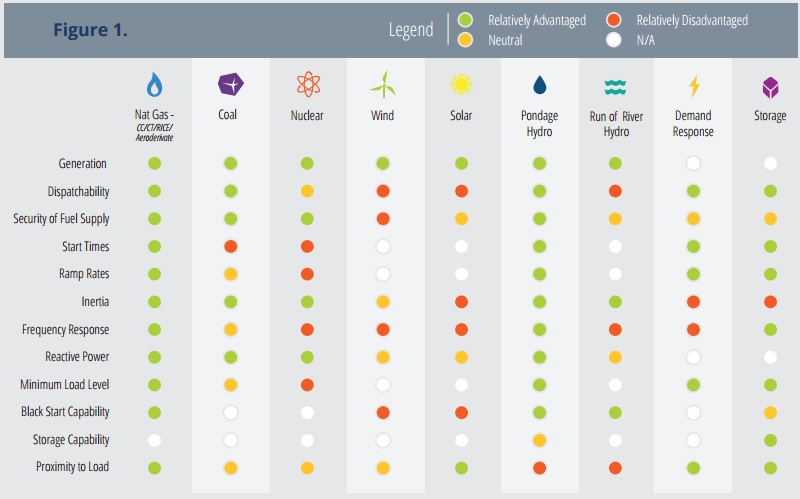Natural Gas and Electric Grid Reliability
Mark Green
Posted June 23, 2017
Natural gas is unique among energy sources to supply needed attributes that ensure the future reliability of the U.S. power grid, a new study finds.
The study by The Brattle Group for API asserts that specific attributes – including dispatchability, ramp rates, frequency response and others – are fundamental to grid reliability, especially as more variable energy sources such as wind and solar come on to the grid. From the study:
Over the last decade, reliance on non-dispatchable generation from wind and solar facilities has grown rapidly. At the same time, falling natural gas prices and more stringent environmental regulations have led natural gas generation to replace output from coal, and, to some extent, retired nuclear resources. Because their output varies based on wind speed and solar insolation, wind and solar generators are sometimes described as “intermittent” or “variable energy” resources. Large variations in output from such resources happen with regularity. At high penetration levels even relatively predictable output variations, such as solar output falling at night, can strain the grid operator’s ability to manage the system.
State-level environmental policies, federal tax incentives, technology advances and other factors make it likely variable energy generators will shoulder more of U.S. power generation in the future. The Brattle study urges restructured electric jurisdictions to consider market approaches to procure the various attributes needed for grid reliability. The study notes two important principles for market designers and system planners:
- Variable generation resources can create additional reliability needs for the system.
- Resources with reliability attributes that meet these needs should be appropriately valued.
Enter natural gas. The study identifies 10 key reliability attributes for grid system health:
- Generation capacity.
- Dispatchability – The ability to change output or consumption levels in response to an order by the system operator.
- Security of fuel supply – Dependability of a resource’s energy inputs or fuel.
- Start times and ramp rates – The speed at which resources can respond to a system operator’s orders to increase and decrease electricity delivered to the grid.
- Inertia and frequency response capability – Resource attributes that help the system maintain required frequency stability.
- Reactive power capability – The ability to deliver reactive power is needed to maintain voltage within certain limits to prevent generator malfunctions or, in the worst case, cascading blackouts.
- Minimum load level – The lowest level of electrical output an energy resource can continuously send to the grid.
- Black start capability – The ability of power plant to restart without relying on the transmission network to deliver power.
- Storage capability – The ability to store electricity helps meet multiple demand requirements.
- Proximity to load – The ability to site resources close to load helps the system meet bulk demand and maintain voltages.
That’s a long, somewhat technical list – yet all support grid reliability that’s essential to modern, every-day life. The matrix below shows how various energy resources support those attributes:

It doesn’t take a scientist to see that natural gas is strong across the board. This isn’t an argument against other energy sources. Rather, it’s a signal that the reliability of the electricity grid that everyone benefits from depends on an array of factors – which natural gas uniquely supports.
API Chief Economist Erica Bowman discussed the study with a group of reporters this week, stressing that natural gas’ importance increases as intermittent energies grow their share of power generation. (We’ve posted before on intermittency – that wind and solar need a partner for when there’s no wind or sunshine, and that natural gas supplies that help.) “Natural gas ensures the reliability of the grid,” Bowman said.
There’s a market argument for natural gas as well. “We advocate free markets,” Bowman said. “When we allow free markets to determine the penetration” of a fuel source, natural gas comes to the fore. One more passage from the Brattle study:
For a variety of reasons related to both policy and economics, the shift towards variable energy resources will likely continue. This change to the system will require the restructured markets and the regulated states to rethink the way they value the different reliability attributes of resources. … [A]s the penetration of variable energy resources increases, more work will be needed in rethinking the traditional way resources’ contributions to reliability are valued. In both markets and regulated states, ensuring reliability will depend on rules that recognize two important reliability principles. First, integrating variable generation resources can increase the need for resources with the reliability attributes discussed in this paper. Second, reliability attributes should be valued in an economically efficient way.
About The Author
Mark Green joined API after a career in newspaper journalism, including 16 years as national editorial writer for The Oklahoman in the paper’s Washington bureau. Previously, Mark was a reporter, copy editor and sports editor at an assortment of newspapers. He earned his journalism degree from the University of Oklahoma and master’s in journalism and public affairs from American University. He and his wife Pamela have two grown children and six grandchildren.


